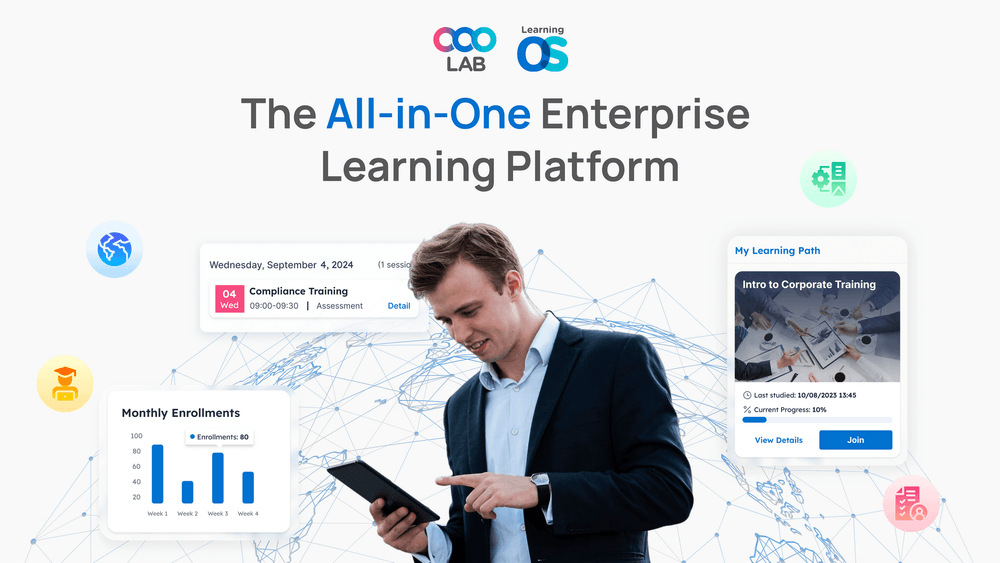

Investing in sales training and enablement is critical for building high-performing sales teams, but organizations must justify these efforts with measurable returns. Calculating the return on investment (ROI) ensures that sales training and enablement programs deliver tangible value, aligning with business goals like revenue growth and efficiency. An enterprise LMS plays a pivotal role by providing data-driven insights to track performance and optimize training outcomes.
This blog explores how to measure ROI on sales training and enablement efforts, offering practical steps and metrics. With data-backed strategies, we will show how an enterprise LMS helps quantify the impact of these initiatives.

Sales training equips reps with skills to close deals, while enablement provides tools and content to enhance performance. These initiatives require significant investments in time, technology, and resources, including platforms like an enterprise LMS. Measuring ROI validates these costs, demonstrates value to stakeholders, and identifies areas for improvement.
A 2024 Brandon Hall Group study found that 65 percent of organizations struggle to quantify training ROI, risking misaligned investments. By leveraging enterprise LMS analytics, companies can track outcomes and ensure sales training drives business success.
>>> Read more: Sales Training Demystified: Why It Matters More Than Ever
>>> Read more: Effective Onboarding Strategies for New Sales Hires: Setting Them Up for Success
ROI measures the financial return of an investment relative to its cost, calculated as:
ROI (%) = [(Gain from Investment – Cost of Investment) / Cost of Investment] × 100
For sales training and enablement, gains include increased revenue, cost savings, and productivity improvements. Costs encompass licensing an enterprise LMS, content development, and trainer time. Both tangible and intangible benefits, like improved rep confidence, must be quantified to assess ROI accurately.
Book Free Demo with us. Bring your Training and Learning to a new height with LearningOS.

>>> Read more: Building Confidence in Your Sales Team Through Training and Development
>>> Read more: Addressing declining retail foot traffic issue
Calculating ROI requires a structured approach, leveraging enterprise LMS data to track outcomes. Below are key steps to measure the impact of sales training and enablement efforts.
Start by aligning sales training goals with business priorities, such as boosting close rates or reducing onboarding time. Define key performance indicators (KPIs) to measure success, including:
Revenue growth from improved sales performance.
Training completion rates via enterprise LMS.
Time to quota for new reps.
Customer satisfaction scores post-training.
Clear KPIs ensure ROI calculations focus on meaningful outcomes.
Accurate ROI requires accounting for all expenses, including:
Enterprise LMS licensing and implementation.
Content creation for sales training modules.
Trainer salaries and administrative costs.
Opportunity costs, like time reps spend training.
A 2023 Deloitte report notes that underestimating costs skews ROI calculations. Comprehensive tracking ensures precision.
Tangible benefits are measurable financial gains, such as:
Revenue Increases: Track sales growth post-sales training, like higher close rates. A 2024 Training Magazine report found that effective training boosts revenue by 15 percent.
Cost Savings: Compare enterprise LMS training costs to in-person sessions, factoring in reduced travel or venue expenses.
Efficiency Gains: Measure reduced onboarding time, translating to faster productivity.
Use enterprise LMS analytics to link these gains to specific training initiatives.
Intangible benefits, like improved morale or confidence, are harder to quantify but impactful. Assign values using proxies:
Productivity: Estimate time saved from better skills, multiplied by average salaries.
Retention: Calculate savings from lower turnover if sales training boosts engagement.
Customer Loyalty: Link improved client feedback to sales training, estimating repeat business value.
Surveys and enterprise LMS feedback tools help quantify these benefits.
An enterprise LMS provides robust analytics to track training impact. Monitor metrics like:
Completion rates and time spent on sales training.
Quiz scores and skill assessments.
Sales performance pre- and post-training.
Compare these metrics to baseline data to measure improvement. For example, if close rates rise 10 percent after sales training, attribute the gain to the program.
Plug data into the ROI formula. For example:
Costs: $50,000 (LMS, content, training).
Gains: $80,000 (revenue growth, savings).
ROI: [($80,000 – $50,000) / $50,000] × 100 = 60 percent.
A positive ROI signals success, but even modest returns can justify investment if intangible benefits are significant. Recalculate periodically to track long-term impact.
Present ROI results to stakeholders using clear visuals, like charts showing revenue growth tied to sales training. Highlight how enterprise LMS data drove insights, reinforcing the program’s value. Tie findings to strategic goals, such as market expansion, to secure ongoing support.
>>> Read more: A guide to teaching sales rep positive response
>>> Read more: Why is employee upskilling non-negotiable for business success
Measuring ROI on sales training and enablement is essential to validate investments and optimize outcomes. By leveraging enterprise LMS analytics, organizations can track revenue, efficiency, and engagement, ensuring sales training drives business success. From setting KPIs to quantifying benefits, these steps provide a clear path to ROI.
Invest in measuring ROI today to maximize the impact of your sales training. With an enterprise LMS, you can prove value, refine strategies, and build a high-performing sales team.
At OOOLAB (pronounced 'uːlæb'), our mission is to make complex learning operations simple. We aim to positively impact the lives of over 1,000,000 learners and educators by the end of 2026.
OOOLAB's LearningOS provides educational institutions and corporate enterprises with an all-in-one solution to create and deliver engaging learning experiences.
We meet organizations' needs or support your growth. We provide undivided attention. We provide:
1. Dedicated success manager: We offer direct communication with a real human who'll discuss your enterprises unique learning operations and goals.
2. Personalized setup: Our team will help you transition to LearningOS on your schedule, one step at a time.
3. Around the clock support: Get help from us any time, and in any time zone.
We have recently launched a new AI training tool, Skill Quotient OS, designed to elevate hybrid training to new heights. It offers role-play exercises with scenarios and assessments.This tool can apply in sales training, corporate development and customer support training in any industry.
Reach out to us at: LinkedIn, Facebook, Instagram, Tiktok, X
1. What are the main benefits of LearningOS
Our platform is easy to use and automates all aspects of your learning operations. It efficiently manages complex tasks, allowing you to concentrate on delivering exceptional learning experiences.
2. What main features does LearningOS offer?
Our all-in-one software solution combines a Content Management System, a Learning Management System, content authoring tools, and a mobile friendly Learner Portal.
3. Can your platform be used for corporate enterprises?
Absolutely! LearningOS is an Enterprise LMS that is a great fit for corporate learning. In fact, we have clients with up to 700,000 employees using LearningOS! Upskill your workforce by creating and assigning interactive eLearning content while effortlessly tracking employee progress.
4. Who currently uses your platform?
Our platform is currently used by over 120,000+ learners, parents, and employees across 21 countries worldwide!
5. What types of content options are available on your platform?
We offer ready-to-go curriculums for various educational purposes or our expert design team can build a custom course for you. We can also upload your existing learning materials and enhance them digitally.
6. What is unique about LearningOS?
Our platform, designed by educators for educators, provides you with all the tools you need to scale. Build and promote your own hybrid and blended learning courses and save money on licensing fees by owning your own proprietary content.
7. How can I get started?
Schedule a meeting with our experts and we’ll talk about how our platform can address your unique challenges and help to grow your business.